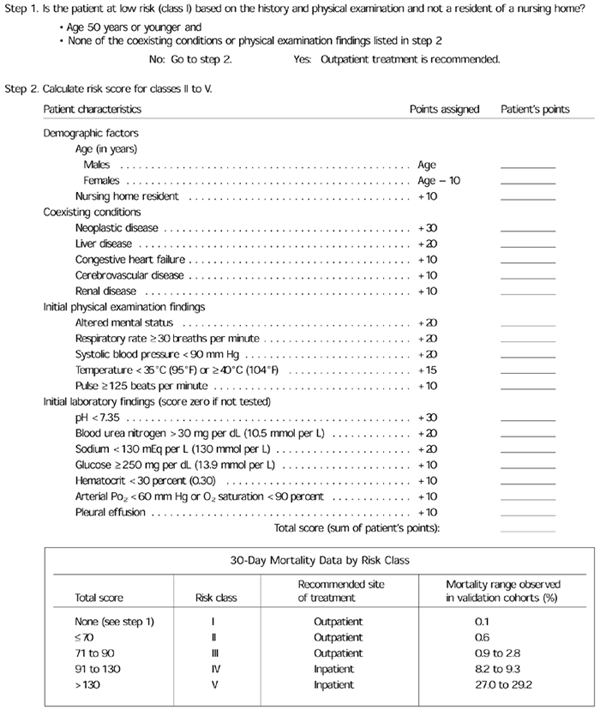
Am Fam Physician. 2003;68(4):729-732
The initial management of community-acquired pneumonia (CAP) in adult patients requires correct diagnosis and a determination of the intensity of treatment required. Because CAP is the only acute respiratory tract infection in which there is increased mortality if antibiotic therapy is delayed, diagnostic and treatment decisions need to be made accurately and efficiently. Metlay and Fine reviewed the literature to identify test characteristics of diagnostic and prognostic factors to develop a strategy for approaching the initial management of radiographically confirmed CAP.
Symptoms at presentation are not useful in distinguishing CAP from respiratory illnesses with other causes. Consideration of the usefulness of physical examination results demonstrated that approximations of the probability of pneumonia based on individual findings could be estimated depending on the cutoff value used to define abnormal findings. Combinations of symptoms and signs have yielded prediction rules. The sensitivity of chest radiography depends greatly on pretest probability. Although chest radiography has been considered the gold standard for diagnosing pneumonia, data on its sensitivity and specificity are limited. The leukocyte count and C-reactive protein level may assist diagnostic accuracy.
Once the diagnosis is established, the short-term prognosis and need for hospitalization should be considered. Symptoms that significantly influence prognosis include dyspnea and confusion. Predictors of increased mortality include comorbid neurologic disease, renal disease, or congestive heart failure. The risk of death also is increased in patients with current hypotension, tachypnea, or hypothermia. The three laboratory test abnormalities associated with increased mortality are azotemia, leukocytosis, and leukopenia. Mortality also is increased when a multilobar infiltrate is identified on the chest radiograph.
The authors conclude that combinations of findings from the history and physical examination can accurately identify about 50 percent of patients with CAP and that chest radiography should be performed to confirm the diagnosis in most patients. Patients with mild illness who do not have vital sign abnormalities and are generally healthy do not require a chest radiograph to exclude CAP. A negative chest radiograph does not rule out pneumonia in patients with moderate to severe illness. These patients may benefit from the initiation of empiric antibiotic therapy and repeat radiography several days later. A prognostic scoring tool, such as the Pneumonia Patient Outcomes Research Team (PORT) Severity Index, can be used to determine the initial site of treatment (see accompanying figure on page 730). A stepwise approach includes identifying preexisting conditions that contraindicate home care, collecting data to calculate a patient's risk class, and recommending home care for patients in the three lowest risk categories, unless clinical judgment determines that home care is not appropriate.
